Strategies for Community Health and Disease Prevention Essay
VerifiedAdded on 2022/11/28
|9
|2615
|474
Essay
AI Summary
This essay delves into the multifaceted realm of community health and disease prevention, with a particular focus on strategies to combat the growing prevalence of Type 2 diabetes. It begins by defining community and its role in health management, emphasizing the importance of identifying key representatives and addressing community issues. The essay then analyzes the impact of behavioral, social, and environmental factors on health inequalities, introducing approaches to promote health through community engagement and education. It explores community-based interaction, program planning, and the concept of community empowerment. The core of the essay focuses on the prevention and management of Type 2 diabetes, outlining strategic areas such as risk factor modification, early identification, and comprehensive care. It highlights key strategies including community-based partnerships, program implementation, and the role of practitioners in facilitating disease prevention. The essay also discusses the role of community empowerment, leadership, and the importance of communication and education. Various theories and models, including the health belief model, are explored to understand and predict health behaviors and design effective community health programs. The essay concludes by summarizing the strategies, models, and approaches used in community health and disease prevention.
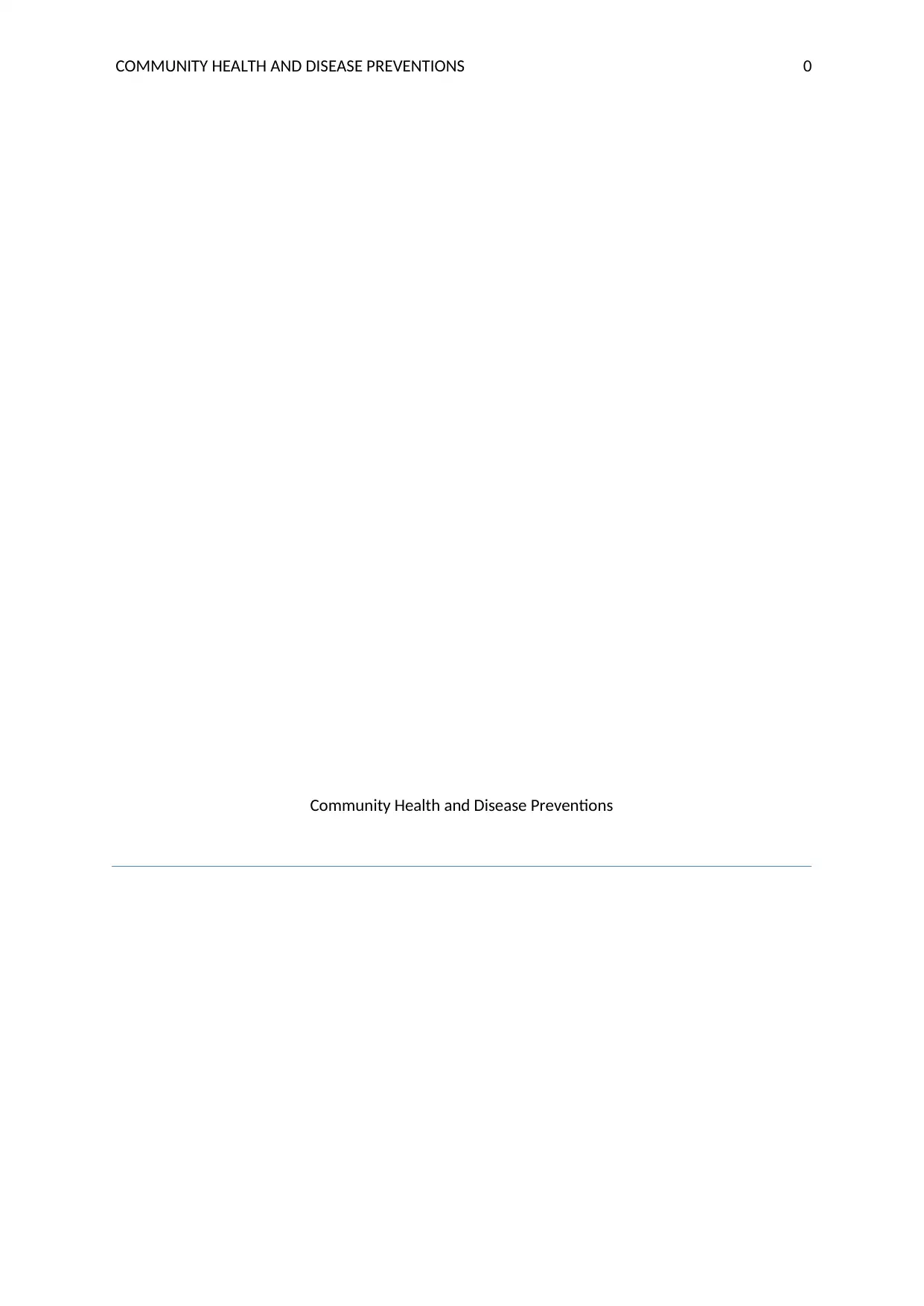
COMMUNITY HEALTH AND DISEASE PREVENTIONS 0
Community Health and Disease Preventions
Community Health and Disease Preventions
Paraphrase This Document
Need a fresh take? Get an instant paraphrase of this document with our AI Paraphraser

COMMUNITY HEALTH AND DISEASE PREVENTIONS 1
The essay focuses on the concept of communities and their health related to
prevention of diseases. Community is a combination and group of people that describes and
experiences common measures that benefitted to their whole management systems. It is about
people who share common perception; adapt changes in society from time to time and they
are mostly nested with each other. It is most important for the whole community to identify
representatives that may avoid the establishment of a dominant minority as well as
community issues (Diaz, 2019).
The analysis of the real impact of behavioural, social and environmental factors on the
health would be evaluated. There are major forces and models that will contribute to the
inequalities of health in the whole communities. The introduction of approach which is
adopted by the promotion of health to motivate and educate communities that directly impact
on people with positivity.
Community-based interaction is a basic concept of communicating with social and
organization well-being with the broader determinants on the lives of members. The needs
are carefully considered in interpreting the concept of communities in program planning
which practice the meaning of community empowerment and participation of the community.
It is very important for practitioners to identify the key differences between participation and
actions to be taken (Laverack, 2019).
The ladder of interaction with the community provides a dynamic and complicated
process. The ladder of community-based interactions analysis the framework with readiness
to communities, actual participation, and engagement with community, organization, and
development, the building of capacity, actions collectiveness and lastly it ends up with
empowerment of communities. Type 2 diabetes is a biggest and large burden on public health
and there is a tremendous rise in this disease recently with consecutive years. It slowly
develops in a body with mild symptoms that realize lack of energy, constant hunger, and
fatigue, loss in weights, excessive thirst and blurry visions.
The strategic formation of type 2 diabetic covers three areas as changing the factors of
risk; evaluate the conditions by promoting healthy eating and emotional well-being. The
second strategy that can be taken in controlling this disease in the community is early
identification and proper planning of the disease. The evidence which emerges and support
the comprehensive care of the team and make to achieve Rehabilitation. The risk factors
comprise of physical inactivity and obesity in the community-based society. The
The essay focuses on the concept of communities and their health related to
prevention of diseases. Community is a combination and group of people that describes and
experiences common measures that benefitted to their whole management systems. It is about
people who share common perception; adapt changes in society from time to time and they
are mostly nested with each other. It is most important for the whole community to identify
representatives that may avoid the establishment of a dominant minority as well as
community issues (Diaz, 2019).
The analysis of the real impact of behavioural, social and environmental factors on the
health would be evaluated. There are major forces and models that will contribute to the
inequalities of health in the whole communities. The introduction of approach which is
adopted by the promotion of health to motivate and educate communities that directly impact
on people with positivity.
Community-based interaction is a basic concept of communicating with social and
organization well-being with the broader determinants on the lives of members. The needs
are carefully considered in interpreting the concept of communities in program planning
which practice the meaning of community empowerment and participation of the community.
It is very important for practitioners to identify the key differences between participation and
actions to be taken (Laverack, 2019).
The ladder of interaction with the community provides a dynamic and complicated
process. The ladder of community-based interactions analysis the framework with readiness
to communities, actual participation, and engagement with community, organization, and
development, the building of capacity, actions collectiveness and lastly it ends up with
empowerment of communities. Type 2 diabetes is a biggest and large burden on public health
and there is a tremendous rise in this disease recently with consecutive years. It slowly
develops in a body with mild symptoms that realize lack of energy, constant hunger, and
fatigue, loss in weights, excessive thirst and blurry visions.
The strategic formation of type 2 diabetic covers three areas as changing the factors of
risk; evaluate the conditions by promoting healthy eating and emotional well-being. The
second strategy that can be taken in controlling this disease in the community is early
identification and proper planning of the disease. The evidence which emerges and support
the comprehensive care of the team and make to achieve Rehabilitation. The risk factors
comprise of physical inactivity and obesity in the community-based society. The
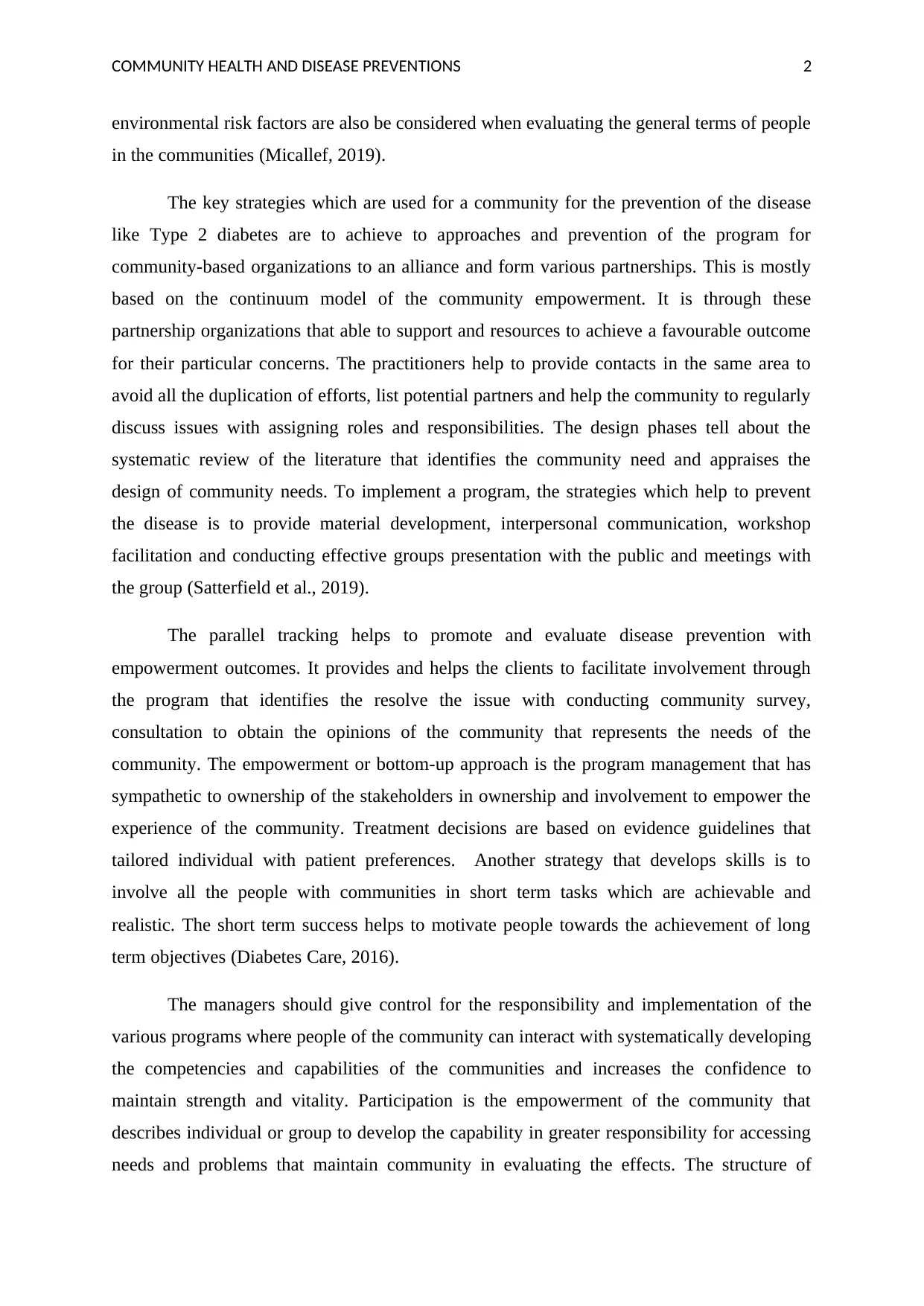
COMMUNITY HEALTH AND DISEASE PREVENTIONS 2
environmental risk factors are also be considered when evaluating the general terms of people
in the communities (Micallef, 2019).
The key strategies which are used for a community for the prevention of the disease
like Type 2 diabetes are to achieve to approaches and prevention of the program for
community-based organizations to an alliance and form various partnerships. This is mostly
based on the continuum model of the community empowerment. It is through these
partnership organizations that able to support and resources to achieve a favourable outcome
for their particular concerns. The practitioners help to provide contacts in the same area to
avoid all the duplication of efforts, list potential partners and help the community to regularly
discuss issues with assigning roles and responsibilities. The design phases tell about the
systematic review of the literature that identifies the community need and appraises the
design of community needs. To implement a program, the strategies which help to prevent
the disease is to provide material development, interpersonal communication, workshop
facilitation and conducting effective groups presentation with the public and meetings with
the group (Satterfield et al., 2019).
The parallel tracking helps to promote and evaluate disease prevention with
empowerment outcomes. It provides and helps the clients to facilitate involvement through
the program that identifies the resolve the issue with conducting community survey,
consultation to obtain the opinions of the community that represents the needs of the
community. The empowerment or bottom-up approach is the program management that has
sympathetic to ownership of the stakeholders in ownership and involvement to empower the
experience of the community. Treatment decisions are based on evidence guidelines that
tailored individual with patient preferences. Another strategy that develops skills is to
involve all the people with communities in short term tasks which are achievable and
realistic. The short term success helps to motivate people towards the achievement of long
term objectives (Diabetes Care, 2016).
The managers should give control for the responsibility and implementation of the
various programs where people of the community can interact with systematically developing
the competencies and capabilities of the communities and increases the confidence to
maintain strength and vitality. Participation is the empowerment of the community that
describes individual or group to develop the capability in greater responsibility for accessing
needs and problems that maintain community in evaluating the effects. The structure of
environmental risk factors are also be considered when evaluating the general terms of people
in the communities (Micallef, 2019).
The key strategies which are used for a community for the prevention of the disease
like Type 2 diabetes are to achieve to approaches and prevention of the program for
community-based organizations to an alliance and form various partnerships. This is mostly
based on the continuum model of the community empowerment. It is through these
partnership organizations that able to support and resources to achieve a favourable outcome
for their particular concerns. The practitioners help to provide contacts in the same area to
avoid all the duplication of efforts, list potential partners and help the community to regularly
discuss issues with assigning roles and responsibilities. The design phases tell about the
systematic review of the literature that identifies the community need and appraises the
design of community needs. To implement a program, the strategies which help to prevent
the disease is to provide material development, interpersonal communication, workshop
facilitation and conducting effective groups presentation with the public and meetings with
the group (Satterfield et al., 2019).
The parallel tracking helps to promote and evaluate disease prevention with
empowerment outcomes. It provides and helps the clients to facilitate involvement through
the program that identifies the resolve the issue with conducting community survey,
consultation to obtain the opinions of the community that represents the needs of the
community. The empowerment or bottom-up approach is the program management that has
sympathetic to ownership of the stakeholders in ownership and involvement to empower the
experience of the community. Treatment decisions are based on evidence guidelines that
tailored individual with patient preferences. Another strategy that develops skills is to
involve all the people with communities in short term tasks which are achievable and
realistic. The short term success helps to motivate people towards the achievement of long
term objectives (Diabetes Care, 2016).
The managers should give control for the responsibility and implementation of the
various programs where people of the community can interact with systematically developing
the competencies and capabilities of the communities and increases the confidence to
maintain strength and vitality. Participation is the empowerment of the community that
describes individual or group to develop the capability in greater responsibility for accessing
needs and problems that maintain community in evaluating the effects. The structure of
⊘ This is a preview!⊘
Do you want full access?
Subscribe today to unlock all pages.

Trusted by 1+ million students worldwide
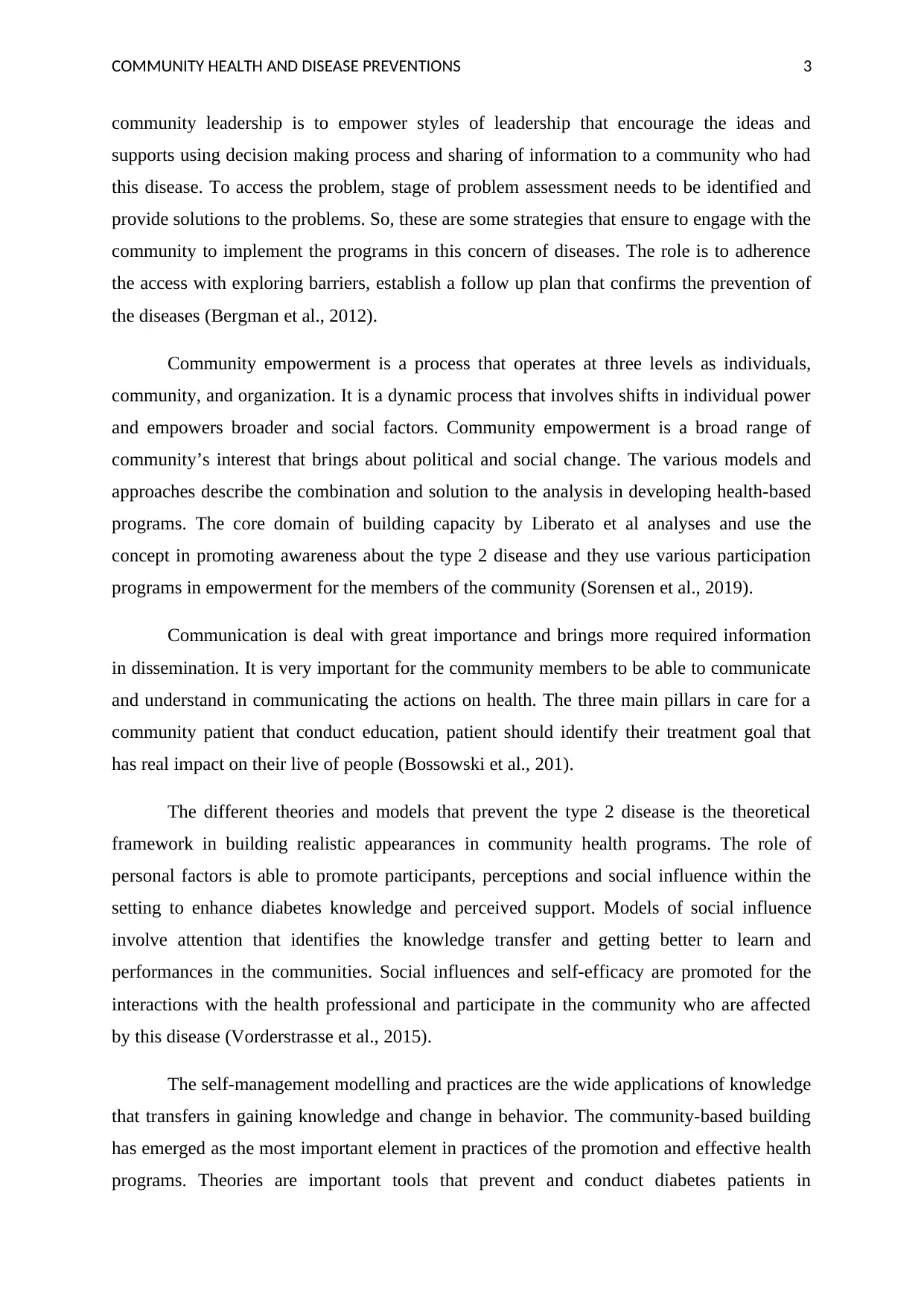
COMMUNITY HEALTH AND DISEASE PREVENTIONS 3
community leadership is to empower styles of leadership that encourage the ideas and
supports using decision making process and sharing of information to a community who had
this disease. To access the problem, stage of problem assessment needs to be identified and
provide solutions to the problems. So, these are some strategies that ensure to engage with the
community to implement the programs in this concern of diseases. The role is to adherence
the access with exploring barriers, establish a follow up plan that confirms the prevention of
the diseases (Bergman et al., 2012).
Community empowerment is a process that operates at three levels as individuals,
community, and organization. It is a dynamic process that involves shifts in individual power
and empowers broader and social factors. Community empowerment is a broad range of
community’s interest that brings about political and social change. The various models and
approaches describe the combination and solution to the analysis in developing health-based
programs. The core domain of building capacity by Liberato et al analyses and use the
concept in promoting awareness about the type 2 disease and they use various participation
programs in empowerment for the members of the community (Sorensen et al., 2019).
Communication is deal with great importance and brings more required information
in dissemination. It is very important for the community members to be able to communicate
and understand in communicating the actions on health. The three main pillars in care for a
community patient that conduct education, patient should identify their treatment goal that
has real impact on their live of people (Bossowski et al., 201).
The different theories and models that prevent the type 2 disease is the theoretical
framework in building realistic appearances in community health programs. The role of
personal factors is able to promote participants, perceptions and social influence within the
setting to enhance diabetes knowledge and perceived support. Models of social influence
involve attention that identifies the knowledge transfer and getting better to learn and
performances in the communities. Social influences and self-efficacy are promoted for the
interactions with the health professional and participate in the community who are affected
by this disease (Vorderstrasse et al., 2015).
The self-management modelling and practices are the wide applications of knowledge
that transfers in gaining knowledge and change in behavior. The community-based building
has emerged as the most important element in practices of the promotion and effective health
programs. Theories are important tools that prevent and conduct diabetes patients in
community leadership is to empower styles of leadership that encourage the ideas and
supports using decision making process and sharing of information to a community who had
this disease. To access the problem, stage of problem assessment needs to be identified and
provide solutions to the problems. So, these are some strategies that ensure to engage with the
community to implement the programs in this concern of diseases. The role is to adherence
the access with exploring barriers, establish a follow up plan that confirms the prevention of
the diseases (Bergman et al., 2012).
Community empowerment is a process that operates at three levels as individuals,
community, and organization. It is a dynamic process that involves shifts in individual power
and empowers broader and social factors. Community empowerment is a broad range of
community’s interest that brings about political and social change. The various models and
approaches describe the combination and solution to the analysis in developing health-based
programs. The core domain of building capacity by Liberato et al analyses and use the
concept in promoting awareness about the type 2 disease and they use various participation
programs in empowerment for the members of the community (Sorensen et al., 2019).
Communication is deal with great importance and brings more required information
in dissemination. It is very important for the community members to be able to communicate
and understand in communicating the actions on health. The three main pillars in care for a
community patient that conduct education, patient should identify their treatment goal that
has real impact on their live of people (Bossowski et al., 201).
The different theories and models that prevent the type 2 disease is the theoretical
framework in building realistic appearances in community health programs. The role of
personal factors is able to promote participants, perceptions and social influence within the
setting to enhance diabetes knowledge and perceived support. Models of social influence
involve attention that identifies the knowledge transfer and getting better to learn and
performances in the communities. Social influences and self-efficacy are promoted for the
interactions with the health professional and participate in the community who are affected
by this disease (Vorderstrasse et al., 2015).
The self-management modelling and practices are the wide applications of knowledge
that transfers in gaining knowledge and change in behavior. The community-based building
has emerged as the most important element in practices of the promotion and effective health
programs. Theories are important tools that prevent and conduct diabetes patients in
Paraphrase This Document
Need a fresh take? Get an instant paraphrase of this document with our AI Paraphraser
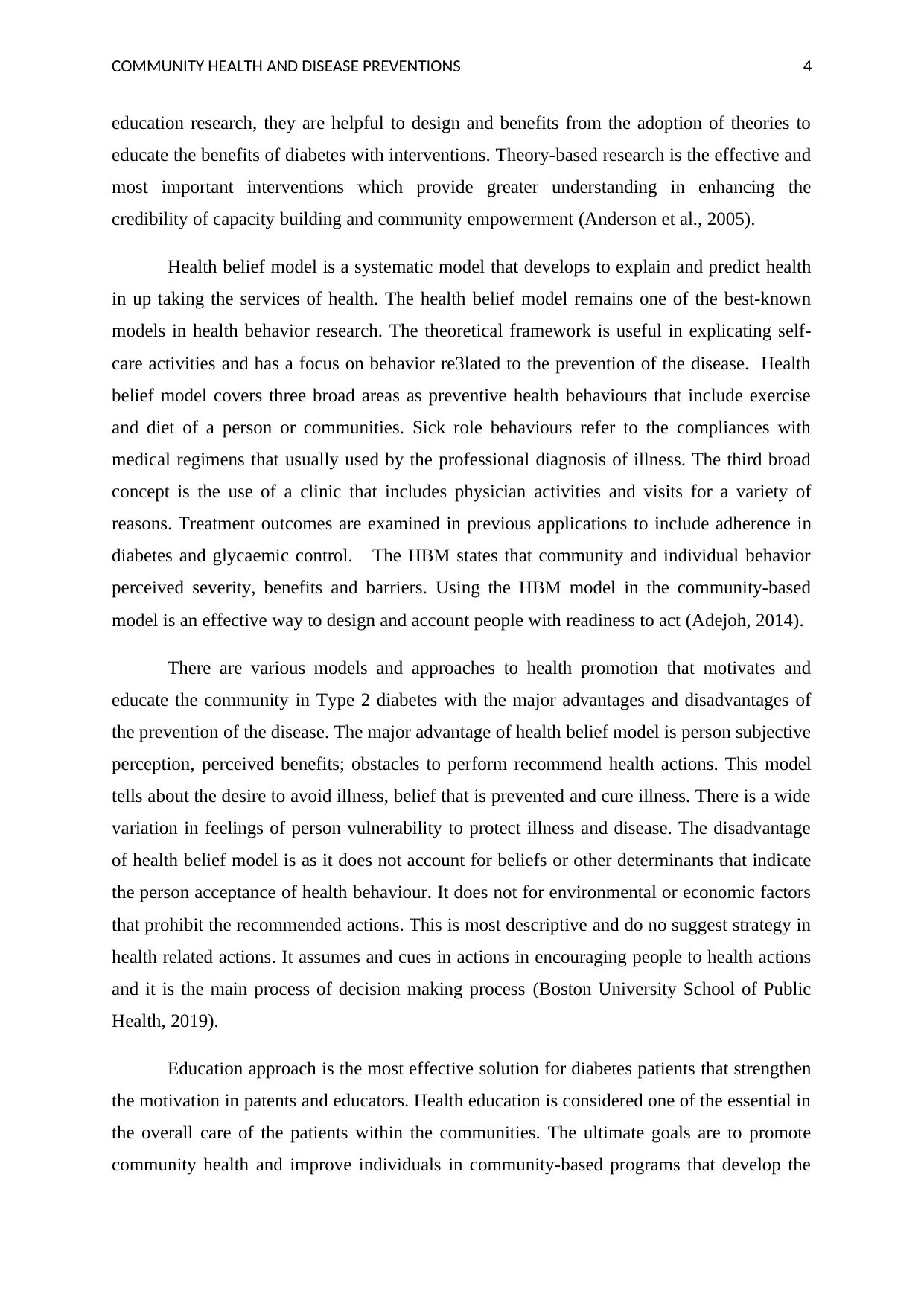
COMMUNITY HEALTH AND DISEASE PREVENTIONS 4
education research, they are helpful to design and benefits from the adoption of theories to
educate the benefits of diabetes with interventions. Theory-based research is the effective and
most important interventions which provide greater understanding in enhancing the
credibility of capacity building and community empowerment (Anderson et al., 2005).
Health belief model is a systematic model that develops to explain and predict health
in up taking the services of health. The health belief model remains one of the best-known
models in health behavior research. The theoretical framework is useful in explicating self-
care activities and has a focus on behavior re3lated to the prevention of the disease. Health
belief model covers three broad areas as preventive health behaviours that include exercise
and diet of a person or communities. Sick role behaviours refer to the compliances with
medical regimens that usually used by the professional diagnosis of illness. The third broad
concept is the use of a clinic that includes physician activities and visits for a variety of
reasons. Treatment outcomes are examined in previous applications to include adherence in
diabetes and glycaemic control. The HBM states that community and individual behavior
perceived severity, benefits and barriers. Using the HBM model in the community-based
model is an effective way to design and account people with readiness to act (Adejoh, 2014).
There are various models and approaches to health promotion that motivates and
educate the community in Type 2 diabetes with the major advantages and disadvantages of
the prevention of the disease. The major advantage of health belief model is person subjective
perception, perceived benefits; obstacles to perform recommend health actions. This model
tells about the desire to avoid illness, belief that is prevented and cure illness. There is a wide
variation in feelings of person vulnerability to protect illness and disease. The disadvantage
of health belief model is as it does not account for beliefs or other determinants that indicate
the person acceptance of health behaviour. It does not for environmental or economic factors
that prohibit the recommended actions. This is most descriptive and do no suggest strategy in
health related actions. It assumes and cues in actions in encouraging people to health actions
and it is the main process of decision making process (Boston University School of Public
Health, 2019).
Education approach is the most effective solution for diabetes patients that strengthen
the motivation in patents and educators. Health education is considered one of the essential in
the overall care of the patients within the communities. The ultimate goals are to promote
community health and improve individuals in community-based programs that develop the
education research, they are helpful to design and benefits from the adoption of theories to
educate the benefits of diabetes with interventions. Theory-based research is the effective and
most important interventions which provide greater understanding in enhancing the
credibility of capacity building and community empowerment (Anderson et al., 2005).
Health belief model is a systematic model that develops to explain and predict health
in up taking the services of health. The health belief model remains one of the best-known
models in health behavior research. The theoretical framework is useful in explicating self-
care activities and has a focus on behavior re3lated to the prevention of the disease. Health
belief model covers three broad areas as preventive health behaviours that include exercise
and diet of a person or communities. Sick role behaviours refer to the compliances with
medical regimens that usually used by the professional diagnosis of illness. The third broad
concept is the use of a clinic that includes physician activities and visits for a variety of
reasons. Treatment outcomes are examined in previous applications to include adherence in
diabetes and glycaemic control. The HBM states that community and individual behavior
perceived severity, benefits and barriers. Using the HBM model in the community-based
model is an effective way to design and account people with readiness to act (Adejoh, 2014).
There are various models and approaches to health promotion that motivates and
educate the community in Type 2 diabetes with the major advantages and disadvantages of
the prevention of the disease. The major advantage of health belief model is person subjective
perception, perceived benefits; obstacles to perform recommend health actions. This model
tells about the desire to avoid illness, belief that is prevented and cure illness. There is a wide
variation in feelings of person vulnerability to protect illness and disease. The disadvantage
of health belief model is as it does not account for beliefs or other determinants that indicate
the person acceptance of health behaviour. It does not for environmental or economic factors
that prohibit the recommended actions. This is most descriptive and do no suggest strategy in
health related actions. It assumes and cues in actions in encouraging people to health actions
and it is the main process of decision making process (Boston University School of Public
Health, 2019).
Education approach is the most effective solution for diabetes patients that strengthen
the motivation in patents and educators. Health education is considered one of the essential in
the overall care of the patients within the communities. The ultimate goals are to promote
community health and improve individuals in community-based programs that develop the
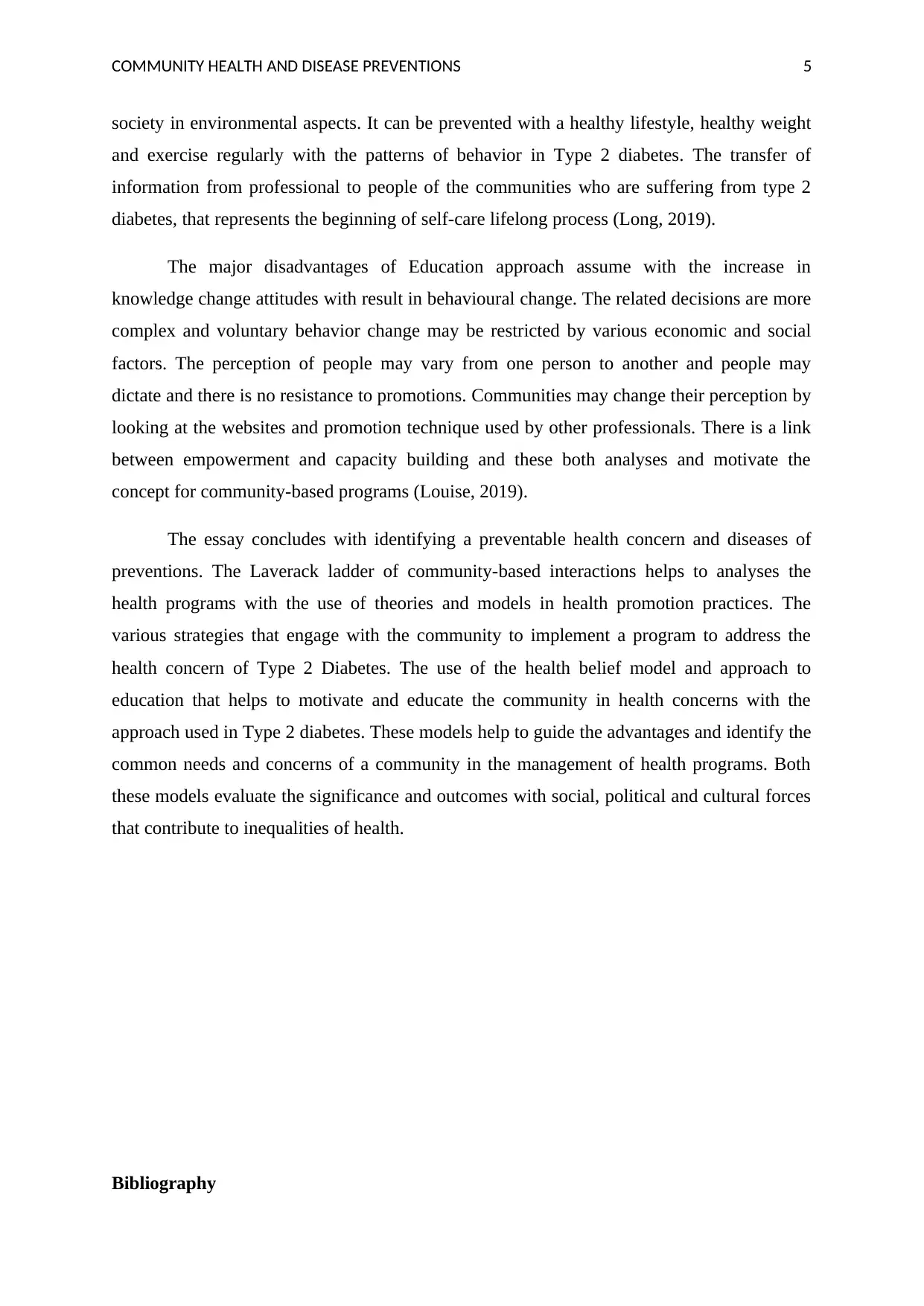
COMMUNITY HEALTH AND DISEASE PREVENTIONS 5
society in environmental aspects. It can be prevented with a healthy lifestyle, healthy weight
and exercise regularly with the patterns of behavior in Type 2 diabetes. The transfer of
information from professional to people of the communities who are suffering from type 2
diabetes, that represents the beginning of self-care lifelong process (Long, 2019).
The major disadvantages of Education approach assume with the increase in
knowledge change attitudes with result in behavioural change. The related decisions are more
complex and voluntary behavior change may be restricted by various economic and social
factors. The perception of people may vary from one person to another and people may
dictate and there is no resistance to promotions. Communities may change their perception by
looking at the websites and promotion technique used by other professionals. There is a link
between empowerment and capacity building and these both analyses and motivate the
concept for community-based programs (Louise, 2019).
The essay concludes with identifying a preventable health concern and diseases of
preventions. The Laverack ladder of community-based interactions helps to analyses the
health programs with the use of theories and models in health promotion practices. The
various strategies that engage with the community to implement a program to address the
health concern of Type 2 Diabetes. The use of the health belief model and approach to
education that helps to motivate and educate the community in health concerns with the
approach used in Type 2 diabetes. These models help to guide the advantages and identify the
common needs and concerns of a community in the management of health programs. Both
these models evaluate the significance and outcomes with social, political and cultural forces
that contribute to inequalities of health.
Bibliography
society in environmental aspects. It can be prevented with a healthy lifestyle, healthy weight
and exercise regularly with the patterns of behavior in Type 2 diabetes. The transfer of
information from professional to people of the communities who are suffering from type 2
diabetes, that represents the beginning of self-care lifelong process (Long, 2019).
The major disadvantages of Education approach assume with the increase in
knowledge change attitudes with result in behavioural change. The related decisions are more
complex and voluntary behavior change may be restricted by various economic and social
factors. The perception of people may vary from one person to another and people may
dictate and there is no resistance to promotions. Communities may change their perception by
looking at the websites and promotion technique used by other professionals. There is a link
between empowerment and capacity building and these both analyses and motivate the
concept for community-based programs (Louise, 2019).
The essay concludes with identifying a preventable health concern and diseases of
preventions. The Laverack ladder of community-based interactions helps to analyses the
health programs with the use of theories and models in health promotion practices. The
various strategies that engage with the community to implement a program to address the
health concern of Type 2 Diabetes. The use of the health belief model and approach to
education that helps to motivate and educate the community in health concerns with the
approach used in Type 2 diabetes. These models help to guide the advantages and identify the
common needs and concerns of a community in the management of health programs. Both
these models evaluate the significance and outcomes with social, political and cultural forces
that contribute to inequalities of health.
Bibliography
⊘ This is a preview!⊘
Do you want full access?
Subscribe today to unlock all pages.

Trusted by 1+ million students worldwide
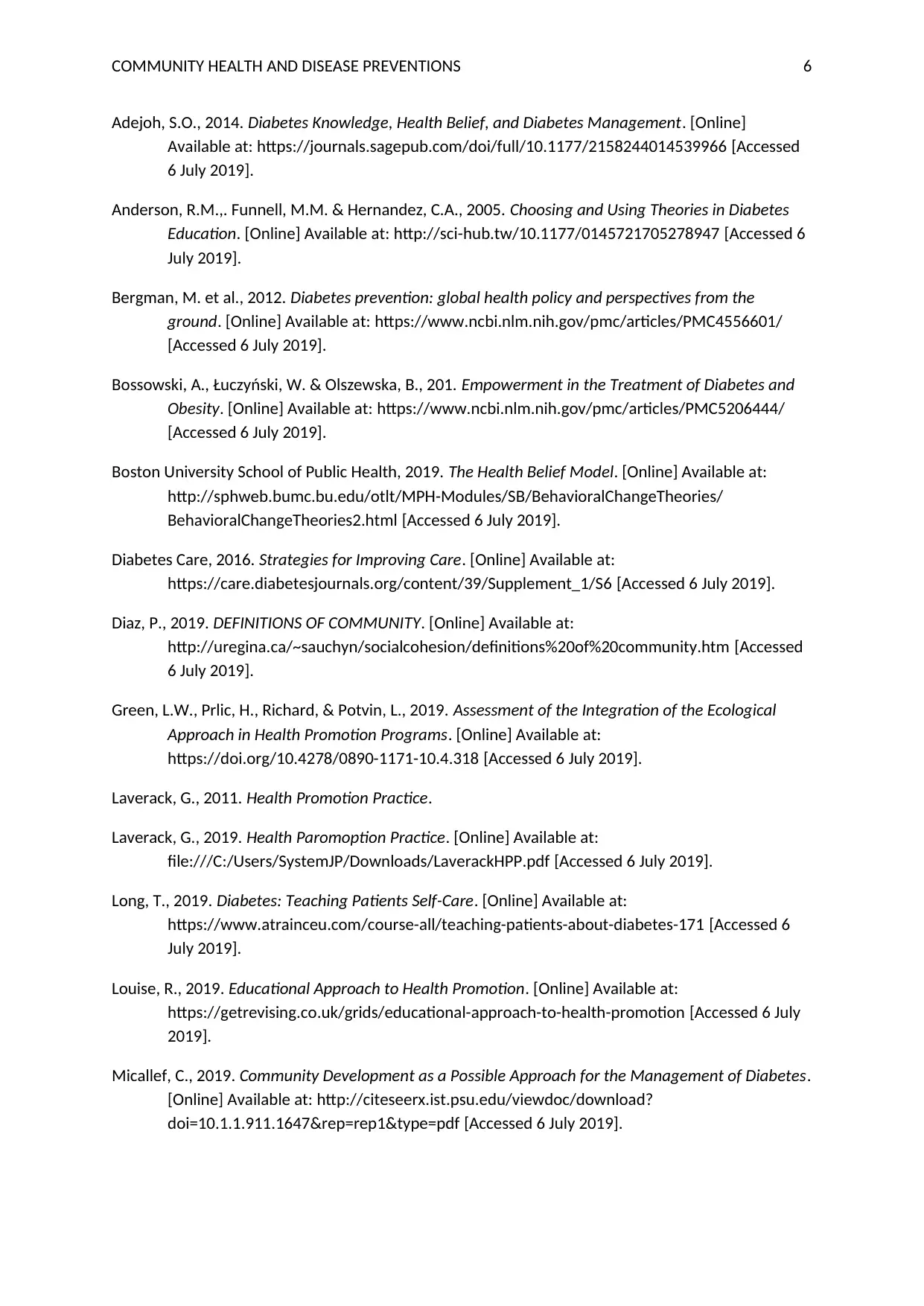
COMMUNITY HEALTH AND DISEASE PREVENTIONS 6
Adejoh, S.O., 2014. Diabetes Knowledge, Health Belief, and Diabetes Management. [Online]
Available at: https://journals.sagepub.com/doi/full/10.1177/2158244014539966 [Accessed
6 July 2019].
Anderson, R.M.,. Funnell, M.M. & Hernandez, C.A., 2005. Choosing and Using Theories in Diabetes
Education. [Online] Available at: http://sci-hub.tw/10.1177/0145721705278947 [Accessed 6
July 2019].
Bergman, M. et al., 2012. Diabetes prevention: global health policy and perspectives from the
ground. [Online] Available at: https://www.ncbi.nlm.nih.gov/pmc/articles/PMC4556601/
[Accessed 6 July 2019].
Bossowski, A., Łuczyński, W. & Olszewska, B., 201. Empowerment in the Treatment of Diabetes and
Obesity. [Online] Available at: https://www.ncbi.nlm.nih.gov/pmc/articles/PMC5206444/
[Accessed 6 July 2019].
Boston University School of Public Health, 2019. The Health Belief Model. [Online] Available at:
http://sphweb.bumc.bu.edu/otlt/MPH-Modules/SB/BehavioralChangeTheories/
BehavioralChangeTheories2.html [Accessed 6 July 2019].
Diabetes Care, 2016. Strategies for Improving Care. [Online] Available at:
https://care.diabetesjournals.org/content/39/Supplement_1/S6 [Accessed 6 July 2019].
Diaz, P., 2019. DEFINITIONS OF COMMUNITY. [Online] Available at:
http://uregina.ca/~sauchyn/socialcohesion/definitions%20of%20community.htm [Accessed
6 July 2019].
Green, L.W., Prlic, H., Richard, & Potvin, L., 2019. Assessment of the Integration of the Ecological
Approach in Health Promotion Programs. [Online] Available at:
https://doi.org/10.4278/0890-1171-10.4.318 [Accessed 6 July 2019].
Laverack, G., 2011. Health Promotion Practice.
Laverack, G., 2019. Health Paromoption Practice. [Online] Available at:
file:///C:/Users/SystemJP/Downloads/LaverackHPP.pdf [Accessed 6 July 2019].
Long, T., 2019. Diabetes: Teaching Patients Self-Care. [Online] Available at:
https://www.atrainceu.com/course-all/teaching-patients-about-diabetes-171 [Accessed 6
July 2019].
Louise, R., 2019. Educational Approach to Health Promotion. [Online] Available at:
https://getrevising.co.uk/grids/educational-approach-to-health-promotion [Accessed 6 July
2019].
Micallef, C., 2019. Community Development as a Possible Approach for the Management of Diabetes.
[Online] Available at: http://citeseerx.ist.psu.edu/viewdoc/download?
doi=10.1.1.911.1647&rep=rep1&type=pdf [Accessed 6 July 2019].
Adejoh, S.O., 2014. Diabetes Knowledge, Health Belief, and Diabetes Management. [Online]
Available at: https://journals.sagepub.com/doi/full/10.1177/2158244014539966 [Accessed
6 July 2019].
Anderson, R.M.,. Funnell, M.M. & Hernandez, C.A., 2005. Choosing and Using Theories in Diabetes
Education. [Online] Available at: http://sci-hub.tw/10.1177/0145721705278947 [Accessed 6
July 2019].
Bergman, M. et al., 2012. Diabetes prevention: global health policy and perspectives from the
ground. [Online] Available at: https://www.ncbi.nlm.nih.gov/pmc/articles/PMC4556601/
[Accessed 6 July 2019].
Bossowski, A., Łuczyński, W. & Olszewska, B., 201. Empowerment in the Treatment of Diabetes and
Obesity. [Online] Available at: https://www.ncbi.nlm.nih.gov/pmc/articles/PMC5206444/
[Accessed 6 July 2019].
Boston University School of Public Health, 2019. The Health Belief Model. [Online] Available at:
http://sphweb.bumc.bu.edu/otlt/MPH-Modules/SB/BehavioralChangeTheories/
BehavioralChangeTheories2.html [Accessed 6 July 2019].
Diabetes Care, 2016. Strategies for Improving Care. [Online] Available at:
https://care.diabetesjournals.org/content/39/Supplement_1/S6 [Accessed 6 July 2019].
Diaz, P., 2019. DEFINITIONS OF COMMUNITY. [Online] Available at:
http://uregina.ca/~sauchyn/socialcohesion/definitions%20of%20community.htm [Accessed
6 July 2019].
Green, L.W., Prlic, H., Richard, & Potvin, L., 2019. Assessment of the Integration of the Ecological
Approach in Health Promotion Programs. [Online] Available at:
https://doi.org/10.4278/0890-1171-10.4.318 [Accessed 6 July 2019].
Laverack, G., 2011. Health Promotion Practice.
Laverack, G., 2019. Health Paromoption Practice. [Online] Available at:
file:///C:/Users/SystemJP/Downloads/LaverackHPP.pdf [Accessed 6 July 2019].
Long, T., 2019. Diabetes: Teaching Patients Self-Care. [Online] Available at:
https://www.atrainceu.com/course-all/teaching-patients-about-diabetes-171 [Accessed 6
July 2019].
Louise, R., 2019. Educational Approach to Health Promotion. [Online] Available at:
https://getrevising.co.uk/grids/educational-approach-to-health-promotion [Accessed 6 July
2019].
Micallef, C., 2019. Community Development as a Possible Approach for the Management of Diabetes.
[Online] Available at: http://citeseerx.ist.psu.edu/viewdoc/download?
doi=10.1.1.911.1647&rep=rep1&type=pdf [Accessed 6 July 2019].
Paraphrase This Document
Need a fresh take? Get an instant paraphrase of this document with our AI Paraphraser
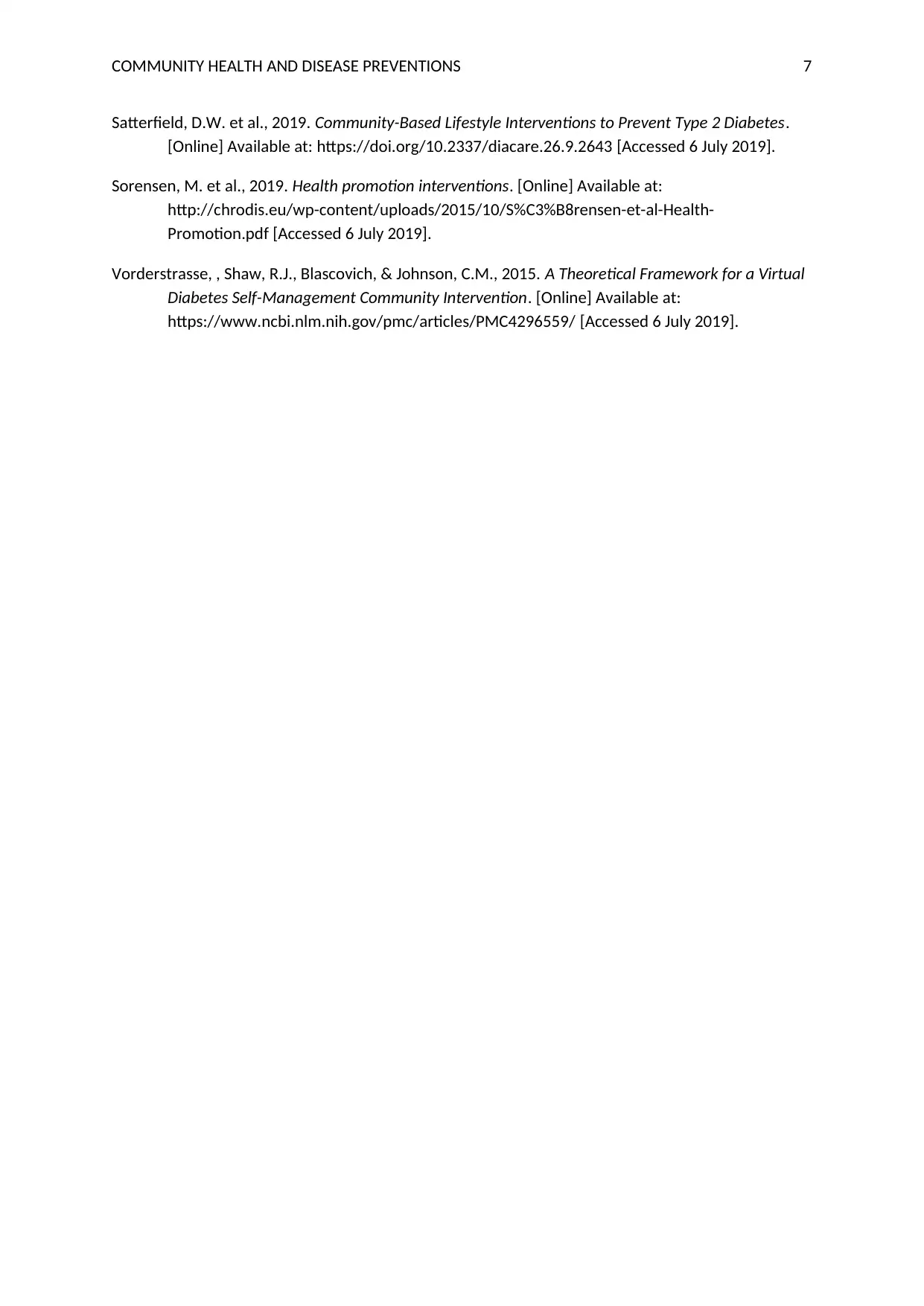
COMMUNITY HEALTH AND DISEASE PREVENTIONS 7
Satterfield, D.W. et al., 2019. Community-Based Lifestyle Interventions to Prevent Type 2 Diabetes.
[Online] Available at: https://doi.org/10.2337/diacare.26.9.2643 [Accessed 6 July 2019].
Sorensen, M. et al., 2019. Health promotion interventions. [Online] Available at:
http://chrodis.eu/wp-content/uploads/2015/10/S%C3%B8rensen-et-al-Health-
Promotion.pdf [Accessed 6 July 2019].
Vorderstrasse, , Shaw, R.J., Blascovich, & Johnson, C.M., 2015. A Theoretical Framework for a Virtual
Diabetes Self-Management Community Intervention. [Online] Available at:
https://www.ncbi.nlm.nih.gov/pmc/articles/PMC4296559/ [Accessed 6 July 2019].
Satterfield, D.W. et al., 2019. Community-Based Lifestyle Interventions to Prevent Type 2 Diabetes.
[Online] Available at: https://doi.org/10.2337/diacare.26.9.2643 [Accessed 6 July 2019].
Sorensen, M. et al., 2019. Health promotion interventions. [Online] Available at:
http://chrodis.eu/wp-content/uploads/2015/10/S%C3%B8rensen-et-al-Health-
Promotion.pdf [Accessed 6 July 2019].
Vorderstrasse, , Shaw, R.J., Blascovich, & Johnson, C.M., 2015. A Theoretical Framework for a Virtual
Diabetes Self-Management Community Intervention. [Online] Available at:
https://www.ncbi.nlm.nih.gov/pmc/articles/PMC4296559/ [Accessed 6 July 2019].

COMMUNITY HEALTH AND DISEASE PREVENTIONS 8
⊘ This is a preview!⊘
Do you want full access?
Subscribe today to unlock all pages.

Trusted by 1+ million students worldwide
1 out of 9
Related Documents
Your All-in-One AI-Powered Toolkit for Academic Success.
+13062052269
info@desklib.com
Available 24*7 on WhatsApp / Email
![[object Object]](/_next/static/media/star-bottom.7253800d.svg)
Unlock your academic potential
Copyright © 2020–2025 A2Z Services. All Rights Reserved. Developed and managed by ZUCOL.




